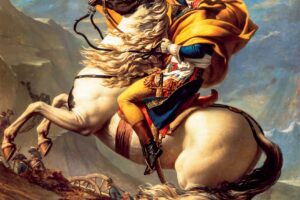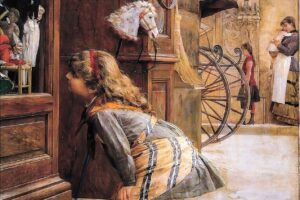A Portrait Beyond Appearances
Napoleon stands in his study, not on a battlefield, but in the quiet command post of empire. At first glance, he appears calm and composed—hand tucked into his uniform, gaze steady. Yet Jacques-Louis David reveals more than just posture. He paints time, pressure, and the weight of a ruler who rarely sleeps.
Midnight in the Tuileries
Look closer. The clock behind him reads 4:13 a.m. The candles are nearly burnt down. His desk is a storm of papers, books, maps, and a sheathed sword. He’s been working through the night, drafting laws, preparing orders, shaping the machinery of the state. This is not just Napoleon the general—it is Napoleon the legislator, the strategist, the architect of modern France.
Symbols of Authority
His uniform gleams with medals and golden epaulettes, but nothing is accidental. The red and white carpet, the lion-footed desk, the carved bees on the chair—all symbols of power, continuity, and ancient Rome. Even the sword resting gently on the velvet seat seems more a symbol of justice than war.
The Hand-in-Waistcoat
That famously tucked hand—calm, composed, thoughtful—became an icon. It suggests both control and confidence, echoing classical statues. Napoleon is not here to impress with movement, but with presence.
David’s Genius in the Details
Jacques-Louis David, once a revolutionary painter, now turned imperial chronicler, masterfully blends realism and symbolism. His brush captures not just flesh and fabric, but intent. The books beneath the desk—Voltaire, Tacitus, and a scroll marked “Code”—remind us that Napoleon was not only a conqueror, but a builder of systems and laws.
A Portrait of Silent Power
In this painting, we see no throne, no battlefield, no crowd. Yet the power is unmistakable. This is a man who rules, even in silence. The Emperor Napoleon in His Study at the Tuileries stands as a timeless tribute to leadership not as ceremony—but as tireless labor.
About Artist

Jacques-Louis David (1748–1825) was a French painter who became the leading figure of Neoclassicism, a movement that rejected the frivolity of the Rococo and sought to revive the moral and aesthetic values of ancient Greece and Rome. His art was not just beautiful; it was a powerful tool for political and social change. David’s work defined a new style that was severe, intellectual, and deeply political, making him a central figure in the French Revolution and later, the court of Napoleon Bonaparte.
Artistic Style and Legacy
David’s style is characterized by a dramatic shift from the soft, sensual curves of Rococo to the sharp lines and moral clarity of Neoclassicism. His paintings are known for:
- Classical Themes and Heroes: He drew heavily from ancient history and mythology to tell stories of virtue, civic duty, and self-sacrifice.
- Sharp, Defined Lines: He rejected the loose brushwork of the Rococo in favor of crisp, sculptural forms that give his figures a sense of heroic grandeur.
- Moral and Political Messages: His art often served as propaganda, urging viewers to embrace patriotism and civic virtue.
- Controlled Lighting: He used strong, raking light to emphasize form and clarity, avoiding the dramatic tenebrism of the Baroque.
Artwork Profile
Here paintings represent the full range of his career, from his early Neoclassical masterpieces to his later works for Napoleon.
- Belisarius Begging for Alms (1781): An early Neoclassical work that depicts the Roman general Belisarius, unjustly fallen into disgrace, begging for money. It’s a clear moral statement about the cruelty of the state.
- The Lictors Bring to Brutus the Bodies of His Sons (1789): A powerful and stark depiction of a Roman leader who chose civic duty over personal love. This painting, with its clear composition and somber tone, was seen as a call for revolutionary sacrifice.
- The Farewell of Telemachus and Eucharis (1782): A more sentimental and intimate work from his early career, it depicts a scene from a classical novel, showing his softer side before his full turn to political subjects.
- The Death of Socrates (1787): One of his most famous masterpieces. It portrays the Greek philosopher Socrates as a moral hero calmly facing death. The painting’s noble composition and stoic emotion made it an icon of Enlightenment ideals.
- The Anger of Achilles (1819): This late painting, from his exile in Brussels, shows David returning to classical subjects with a more refined and emotionally charged style.
- Oath of the Horatii (1784): Arguably his most famous work and a manifesto of Neoclassicism. It depicts three Roman brothers swearing an oath to their father, prioritizing duty to Rome over family. Its stark, geometric composition and powerful moral theme made it an instant sensation.
- Napoleon Crossing the Alps (1801): A famous equestrian portrait of Napoleon as a heroic figure. The painting is a work of political propaganda, portraying Napoleon as a dynamic and determined leader.
- The Emperor Napoleon in His Study at the Tuileries (1812): A more intimate portrait of Napoleon, but one that still emphasizes his power and intellectual prowess. It shows the emperor standing in his study late at night, a subtle nod to his tireless work ethic.



